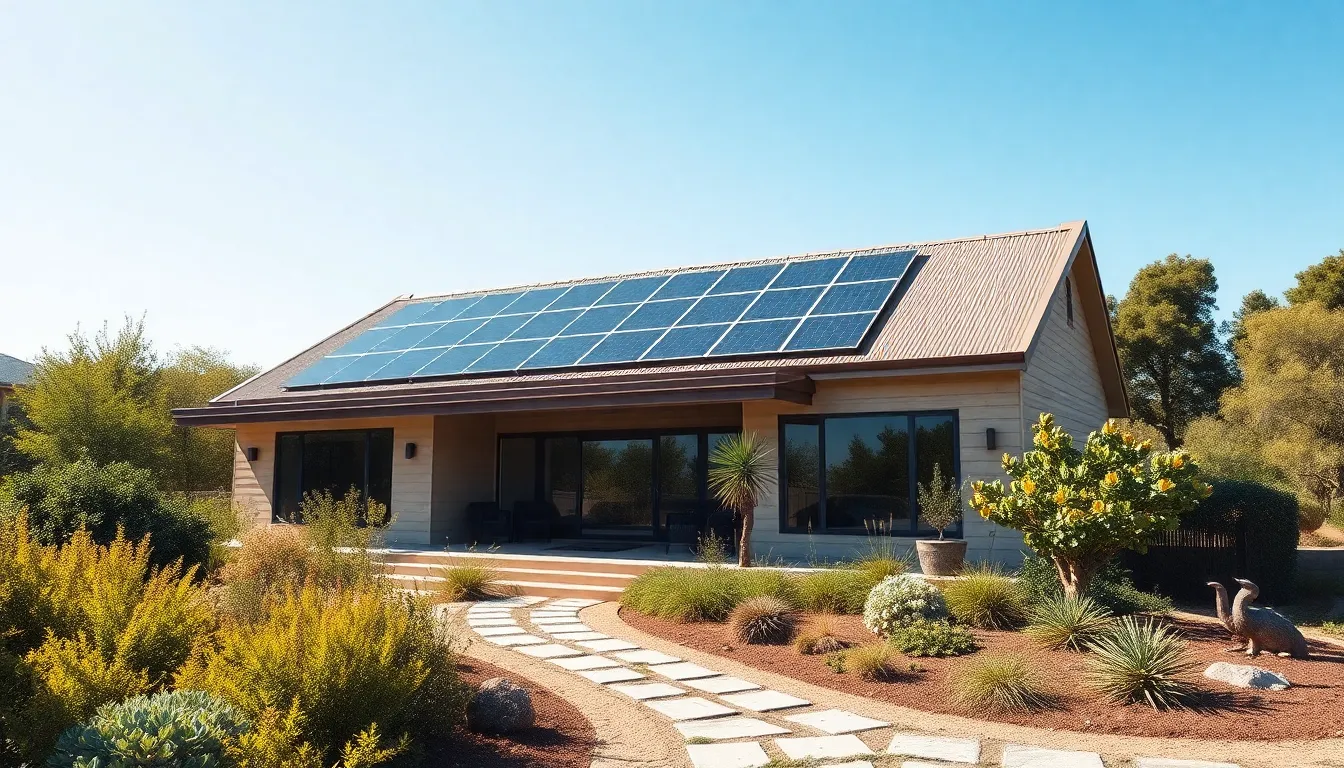In a world where the latest trends seem to change faster than the weather, sustainable homes are the cool kids on the block. They’re not just a passing fad; they’re the future of living. Imagine a home that not only looks good but also helps save the planet—talk about a win-win! With eco-friendly materials and energy-efficient designs, sustainable homes bring a fresh twist to the age-old concept of “home sweet home.”
But don’t worry; going green doesn’t mean sacrificing comfort or style. These homes are packed with innovative features that make living sustainably feel less like a chore and more like a lifestyle choice. So, whether you’re a tree-hugging eco-warrior or just someone who likes a lower utility bill, sustainable homes offer something for everyone. Let’s dive into the world of sustainable living and discover how it can transform everyday life into something extraordinary.
Table of Contents
ToggleOverview of Sustainable Homes
Sustainable homes incorporate eco-friendly practices and materials to minimize environmental impact. These structures utilize resources efficiently, promoting a healthier lifestyle. Energy-efficient designs feature advanced insulation and energy-saving appliances, lowering energy consumption significantly. Renewable energy sources, such as solar panels and wind turbines, often power these homes, enhancing sustainability.
Energy-efficient windows reduce heating and cooling costs. Smart home technology allows residents to monitor energy usage, enabling them to make informed decisions. Water conservation measures, including rainwater harvesting and low-flow fixtures, further contribute to sustainable living.
Green building materials, like bamboo and recycled metal, offer durability and aesthetic appeal. Many homeowners choose to integrate native landscaping, which supports local ecosystems and conserves water. Sustainable homes also prioritize indoor air quality, using non-toxic paints and finishes to reduce health risks.
Government incentives encourage the adoption of sustainable building practices by offering tax credits and rebates. Homeowners enjoy long-term savings through reduced utility bills and increased property value. Many communities support sustainable development initiatives, reinforcing the movement toward greener living.
Architects and builders specialize in creating designs that align with sustainability goals, providing options for various budgets and preferences. People are increasingly recognizing the importance of sustainable homes, understanding that choices made today impact future generations.
Benefits of Sustainable Homes

Sustainable homes offer remarkable advantages that impact both individual lives and the planet. These benefits include environmental responsibility and economic savings.
Environmental Impact
Sustainable homes significantly lower carbon footprints. By using renewable energy sources like solar panels, these homes reduce dependency on fossil fuels. Water conservation strategies, such as rainwater harvesting, manage resources more efficiently. Native landscaping not only beautifies properties but also supports local ecosystems. Advanced insulation minimizes energy loss, promoting energy efficiency. Additionally, non-toxic materials enhance indoor air quality, fostering healthier living environments.
Economic Advantages
Homeowners experience substantial savings through reduced utility bills. Energy-efficient appliances consume less power, translating to lower monthly expenses. Government incentives, including tax credits, further boost financial benefits. Increased property value occurs as sustainable features attract buyers looking for eco-friendly homes. Investing in sustainable building materials often leads to lower maintenance costs over time. Long-term savings become evident as sustainable homes maintain their appeal in the real estate market.
Key Features of Sustainable Homes
Sustainable homes feature several key elements that enhance efficiency and minimize environmental impact. Each component plays a vital role in creating a green living space.
Energy Efficiency
Energy-efficient designs incorporate technologies that reduce energy consumption. Homebuilders often install high-performance insulation, which keeps indoor spaces comfortable by minimizing heat loss. Additionally, energy-saving appliances feature energy star ratings, indicating lower electricity usage. Smart home technology links devices to optimize energy management, making it easier to track and adjust usage. Solar panels facilitate the generation of renewable energy, allowing homeowners to leverage natural resources effectively. Integrating these features results in lower utility bills and a reduced carbon footprint.
Sustainable Materials
Sustainable homes utilize eco-friendly materials that promote environmental responsibility. Bamboo, for instance, serves as a fast-growing, renewable resource for flooring and cabinetry, thanks to its rapid maturity cycle. Recycled metal and reclaimed wood find new life in construction, reducing waste in landfills. Non-toxic paints and finishes contribute to healthier indoor air quality, enhancing the overall living experience. Choosing local materials further diminishes transportation emissions and supports regional economies. By prioritizing these options, sustainable homes enhance durability while appealing to eco-conscious buyers.
Water Conservation
Water conservation methods play a crucial role in sustainable living. Rainwater harvesting systems capture and store precipitation for irrigation and non-potable uses. Low-flow fixtures reduce water waste in kitchens and bathrooms without sacrificing performance. Xeriscaping incorporates drought-resistant plants, minimizing the need for irrigation. Homeowners enjoy reclaimed water systems that recycle greywater for landscape use, further reducing reliance on municipal water supplies. Implementing these measures conserves valuable resources and fosters a sustainable lifestyle.
Designing a Sustainable Home
Designing a sustainable home involves careful planning and thoughtful choices. Effective strategies incorporate passive design principles and innovative technologies.
Passive Design Principles
Passive design principles use natural resources for heating and cooling. Orientation plays a crucial role in maximizing sunlight while minimizing heat loss. Well-placed windows enhance natural ventilation, allowing fresh air to circulate without relying on mechanical systems. Thermal mass materials, such as concrete and stone, absorb heat during the day and release it at night, maintaining a stable indoor temperature. Landscaping choices further support passive strategies, with trees providing shade during summer and windbreaks during winter.
Innovative Technologies
Innovative technologies transform the concept of sustainable living. Smart home systems optimize energy use by automating lighting, heating, and cooling based on occupancy and preferences. Energy-efficient appliances significantly reduce power consumption and often qualify for rebates. Solar panels offer homeowners a renewable energy source, decreasing dependence on traditional grid power. Rainwater collection systems provide an alternative water supply for irrigation and cleaning, supporting conservation efforts and reducing utility costs. These technologies empower homeowners to create truly efficient environments.
Challenges in Sustainable Home Construction
Sustainable home construction faces several challenges that can hinder its growth. High initial costs often deter potential homeowners from investing in eco-friendly options. Establishing a budget that accommodates the premium prices of sustainable materials and technologies proves difficult for many, limiting accessibility.
Another significant obstacle stems from a lack of skilled labor familiar with sustainable practices. Training a workforce capable of implementing green building techniques and technologies remains essential. This gap often leads to fewer sustainable construction projects being completed successfully.
Availability of sustainable materials poses additional challenges. While demand for eco-friendly products has risen, consistent supply can be a concern. Sourcing materials locally may sometimes not meet the quality or sustainability standards, forcing builders to compromise on their environmental goals.
Regulatory hurdles can also impede progress in sustainable construction. Building codes and zoning laws may not support innovative eco-friendly designs, forcing architects and builders to conform to outdated regulations. Navigating these regulations often adds time and costs to the construction process.
Resistance to change from traditional construction methods further complicates efforts in building sustainable homes. Many contractors and builders prefer established approaches, leading to slow adoption of new techniques. Convincing stakeholders of the long-term benefits of sustainable construction can require extensive educational efforts.
Public awareness plays a crucial role, as many homeowners lack understanding of the advantages of sustainable living. Without recognition of the financial and environmental benefits, consumer demand may remain limited. Engaging communities through workshops and outreach programs can enhance knowledge and foster support for sustainable practices.
Addressing these challenges will strengthen the journey toward sustainable home construction while supporting environmental goals.
Sustainable homes represent a significant shift in how people approach living spaces. They combine comfort with eco-friendly practices to create a healthier environment. As technology advances and awareness grows, the barriers to adopting sustainable living continue to diminish.
The benefits extend beyond individual homeowners to the broader community and planet. By choosing sustainable options, individuals can contribute to a greener future while enjoying long-term savings.
With increased support from governments and the construction industry, the dream of sustainable living is becoming a reality for many. Embracing this lifestyle is not just a choice; it’s a commitment to a better world for future generations.


